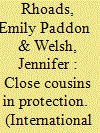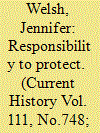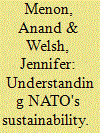| Srl | Item |
| 1 |
ID:
167112


|
|
|
|
|
| Summary/Abstract |
The Protection of Civilians (PoC) in peacekeeping and the Responsibility to Protect (R2P) populations from atrocity crimes are two norms that emerged at the turn of the new millennium with the aim of protecting vulnerable peoples from mass violence and/or systematic and widespread violations of human rights. To date, most scholars have analysed the discourses over the status, strength and robustness of both norms separately. And yet, the distinction between the two has at times been exceptionally fine. In this article, we analyse the constitutive relationship between PoC and R2P, and the impact of discursive and behavioural contestation on their joint evolution within the UN system and state practice over three phases (1999–2005; 2006–10; 2011–18). In so doing, we contribute to the International Relations literature on norms by illuminating ideational interplay in the dynamics of norm evolution and contestation. More specifically, we illustrate how actors may seek to strengthen support for one norm, or dimension of a norm, by contrasting it or linking it with another. Our analysis also reveals that while the two norms of R2P and PoC were initially debated and implemented through different institutional paths and policy frameworks, discursive and behavioural contestation has in more recent years brought them closer together in one important respect. The meaning ascribed to both norms—by representatives of states and institutions such as the United Nations—has become more state-centric, with an emphasis on building and strengthening the capacity of national authorities to protect populations. This meaning contrasts with the more cosmopolitan origins of R2P and PoC, and arguably limits possibilities for the external enforcement of both norms through any form of international authority that stands above or outside sovereign states. This article forms part of the special section of the May 2019 issue of International Affairs on ‘The dynamics of dissent’, guest-edited by Anette Stimmer and Lea Wisken.
|
|
|
|
|
|
|
|
|
|
|
|
|
|
|
|
| 2 |
ID:
145731


|
|
|
|
|
| Summary/Abstract |
This article engages with the debate on the efficacy of the Responsibility to Protect (R2P) in the wake of the Arab Spring by articulating a defence of its role in preventing the commission, escalation, or recurrence of atrocity crimes. Taking as its starting point the claim by UN Secretary-General (UNSG) Ban Ki-moon that prevention remains the most important aspect of the principle of R2P, the article illustrates the extent to which prevention is embedded in R2P, the means by which it can be leveraged, and the obstacles to its operationalisation. The first section outlines why and how the prevention of the four crimes identified in the 2005 World Summit Outcome Document became so important to UN member states. The second section analyses efforts to implement the commitment to prevention within the UN, regional organisations, and individual states. The final section offers an explanation for why prevention is in fact a controversial practice – despite the universal rhetorical commitment to its prioritisation – and advances a series of steps which might be undertaken to advance it.
|
|
|
|
|
|
|
|
|
|
|
|
|
|
|
|
| 3 |
ID:
115599


|
|
|
|
|
| Publication |
2012.
|
| Summary/Abstract |
Although the humanitarian rationale for the use of force has gained legitimacy, the consensus around this legitimacy … has remained both narrow and fragile.
|
|
|
|
|
|
|
|
|
|
|
|
|
|
|
|
| 4 |
ID:
102350


|
|
|
|
|
| Publication |
2011.
|
| Summary/Abstract |
Our assumption in this article is that sustainable peace operations require
the involvement of organizations and institutions that are themselves sustainable.
We begin by presenting a set of propositions regarding the sustainability
of international institutions in which the capacity for
adaptation and incremental change are centrally important. We then examine
these propositions in relation to NATO, paying particular attention
to the ways in which the alliance has taken on both new roles and new
members. A central concern of the article is the ways in which NATO member
states' conceptions of identity and definitions of national interest affect
the sustainability of the alliance, and limit the ability of alliance
members to generate the longer-term commitment needed for peace support
operations.
|
|
|
|
|
|
|
|
|
|
|
|
|
|
|
|